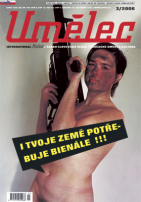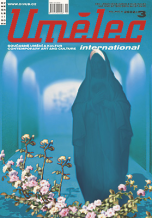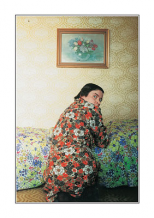| Umělec magazine 2006/3 >> UNAUTHORISED Banksy, Street Art and Private Property | List of all editions. | ||||||||||||
|
|||||||||||||
UNAUTHORISED Banksy, Street Art and Private PropertyUmělec magazine 2006/301.03.2006 Chris Gill | street and art | en cs de |
|||||||||||||
|
The following story is part of urban art folklore: a young graffiti artist called Banksy, reportedly Robin Banks from Bristol in South West England, is jeered upon telling his sister that he will one day be an exhibited artist in the Lourve. Fast-forward to today, and Banksy has been exhibited in the Lourve, the Tate Britain, and four of the most prestigious museums in New York City.
This is not your typical fairytale, however. There was no gradual recogni-tion of his life’s work by the art establishment, leading to his work being chosen for these world renowned galleries, as you might expect. Instead, Banksy put on a fake beard, carried his art into the galleries and glued them to the wall. He actually ‘hit‘ the four museums in New York, including the Metropol-itan Museum and Natural History Museum, on the same day in March 2005, leaving a glass-encased beetle with missiles atta-ched to its fighter pilot wings in the latter, which went undetected for several days. Banksy told Reuters, “Obviously th-ey’ve got their eye a lot more on things leaving than things going in, which works in my favor. I imagine they’ll be doing stricter bag checks now.” Banksy thrives on illegal exhibition and mischievous stunts. He exists in the public glare primarily through his graffiti that decorates the walls of many major world cities. The clean lines of stenciling are where he specializes. Black-and-white social commentaries such as two policemen kissing, children hugging bombs or wearing gas masks or the Mona Lisa about to fire a rocket launcher, make the pedestrian look and think about the world around them. Whether it be the London stencil of a rat painting the words “its not a race” or the series of rats he stenciled in Los Angeles, including one on Melrose Avenue asking “where is Hollywood?” or the dead rat wearing sunglasses he left in the Natural History Museum in April 2004, Banksy’s work has a noticeable recurring vermin theme. He sees his rat militia as a metaphor: “It’s about underground culture, the things that come up from the sewer. I like the idea of nicely tooled up vermin.” Other pieces of animal vandalism include breaking into Bristol Zoo and spraying “Keeper smells – Boring, Boring, Boring” inside Wendy the Elephant’s cage in testament to her 17 years imprisonment, and “We’re bored of fish – We wanna go home” inside the penguin enclosure at London Zoo. Whilst the body of Banksy’s graffiti are numerous, but isolated visual political statements, the brain are the nine pieces he painted on the Palestinian side of 450 mile long Israeli security fence in the West Bank, in August 2005. Under the duress of having guns pointed at him by the Israeli army, Banksy painted a child sitting at the bottom of a ladder that scales to the top of the fence, the head and feet of a giant white horse, and two white armchairs and a table looking out through a huge window into a colourful mountainous paradise. Banksy condemns the wall, declared illegal by the International Court of Justice, and told the BBC the wall was “the ultimate activity holiday destination for graffiti writers.” The comparison with the use of Berlin wall as an artistic space of the oppressed is obvious. He also keeps his identity well-guarded, but not to the point of anonymity; as in the age-old graffiti tradition he tags his pieces with the Banksy logo, which is of course stenciled. This is partly through necessity, with his line of work being at odds with global private property laws, and partly through choice; his distaste for the art establishment is demonstrated by the “Mind the Crap” warnings he sprayed on the steps of the Tate Britain on the day of the Turner Prize ceremony in 2001. The ubiquity and accessibility of his work have bestowed him with celebrity status. Some critics say his international profile has led him to hypocritically dip his toes too deeply into the mainstream, to sell-out for commercial success. Its not exactly Bob Dylan going electric, but Banksy’s greatest hits anthology “Wall and Piece” was published in 2005 by Random House, a sub-division of Bertelsmann, the largest book publisher in the world. Private Property Protection Bertrand Russell said: “It is preoccupation with possession, more than anything else, that prevents men from living free and nobly.” But for law makers and enforcers, private property legislation is thought necessary to protect the systematic consumption that stimulates economic growth in the wondrous free market miracle. Why invest in real estate if someone is just going to deface it? They dictate where we live, where we can walk and even where we can go to the toilet, as this writer found out recently when a friend was fined Kč 1000 for “pissing on a historical building.“ Individuality is resigned to exist in the spaces left between the dictaats. And it is there, where certain unauthorised art forms blossom into subcultures. From the visual element of this space, emerged graffiti in New York in the 1960s. It subsequently spread across the globe as an art form that symbolically resisted the hegemonic corporatisation of the aesthetic of the shared urban landscape; although even anthropologists struggle with when someone first found beauty in the simplistic brilliance of paint on a wall Street Art to Street Mess The Czech Republic is a perfect example of a place where street art has become street mess in the eyes of law enforcers and public opinion. Street art in the Czech Republic peaked in the 1980s. At this time municipal authorities were leaner in punishments, young Czechs first started listening to hip-hop, and Prague was considered amongst the best cities in the world for graffiti. Today, the Czech Republic is still awash with colour. This takes the form primarily of tags, but there are also some stunning pieces around by the likes of Eugene, Zlo and Piano33. But with the municipal crackdown, graffiti is now an altogether riskier enterprise. Jaroslava Hrabálková, the fifty two year old “sprayer doyenne” from Brno, who was recently imprisoned, would testify to this. And whilst graffiti is continuously outlawed, corporate billboards will continue to pop up everywhere. Prague’s historic centre will continue to be plastered over by hundreds of new billboards over the next decade, cementing advertising’s position as the primary urban aesthetic. And so the space graffiti occupies in the public mindset is contradictory: people want to live in attractive places, yet most see street art as a sign of degradation, not creativity. People want to feel control within the place they live, yet nobody protests when another billboard is erected. And this contradiction can be extended to Banksy. His works are the anti-war, anti-corporate billboards of our shared urban spaces, yet the “Banksy Brand” thrives on the publicity of his stunts in the mainstream media, which he claims to detest. To some he is a subversive vandal, to others a mysterious genius. But to most he is just an artist that fills the drab architecture of our cities with funny, thought provoking visions.
01.03.2006
Recommended articles
|
|||||||||||||
|
04.02.2020 10:17
Letošní 50. ročník Art Basel přilákal celkem 93 000 návštěvníků a sběratelů z 80 zemí světa. 290 prémiových galerií představilo umělecká díla od počátku 20. století až po současnost. Hlavní sektor přehlídky, tradičně v prvním patře výstavního prostoru, představil 232 předních galerií z celého světa nabízející umění nejvyšší kvality. Veletrh ukázal vzestupný trend prodeje prostřednictvím galerií jak soukromým sbírkám, tak i institucím. Kromě hlavního veletrhu stály za návštěvu i ty přidružené: Volta, Liste a Photo Basel, k tomu doprovodné programy a výstavy v místních institucích, které kvalitou daleko přesahují hranice města tj. Kunsthalle Basel, Kunstmuseum, Tinguely muzeum nebo Fondation Beyeler.
|


































 We Are Rising National Gallery For You! Go to Kyjov by Krásná Lípa no.37.
We Are Rising National Gallery For You! Go to Kyjov by Krásná Lípa no.37.
Comments
There are currently no comments.Add new comment